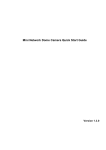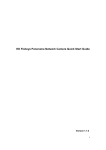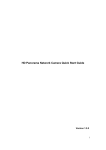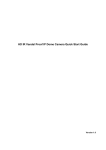Download F Series Indoor IP Camera Quick Start Guide
Transcript
HD IR Waterproof Fixed Network Camera (With Integrated Bracket) Quick Start Guide Version 3.3.3 Welcome Thank you for purchasing our network camera! This quick start guide is designed to be a reference tool for your system. Please keep this start guide well for future reference. Please open the accessory bag to check the items one by one in accordance with the list below. Contact your local retailer ASAP if something is missing or damaged in the bag. Before your operation please read the following instructions carefully. 1.Electrical safety All installation and operation here should conform to your local electrical safety codes. The power shall conform to the requirement in the SELV (Safety Extra Low Voltage) and the Limited power source is rated 12V DC or 24V AC in the IEC60950-1. (Refer to general introduction) Please note: Do not connect two power supplying sources to the device at the same time; it may result in device damage! We assume no liability or responsibility for all the fires or electrical shock caused by improper handling or installation. We are not liable for any problems caused by unauthorized modification or attempted repair. 2.Transportation security Heavy stress, violent vibration or water splash are not allowed during transportation, storage and installation. 3.Installation Do not apply power to the camera before completing installation. Please install the proper power cut-off device during the installation connection. Always follow the instruction guide the manufacturer recommended. 4.Qualified engineers needed All the examination and repair work should be done by the qualified service engineers. We are not liable for any problems caused by unauthorized modifications or attempted repair. 5.Environment This series network camera should be installed in a cool, dry place away from direct sunlight, inflammable, explosive substances and etc. Please keep it away from the electromagnetic radiation object and environment. Please make sure the CCD (CMOS) component is out of the radiation of the laser beam device. Otherwise it may result in CCD (CMOS) optical component damage. Please keep the sound ventilation. Do not allow the water and other liquid falling into the camera. i Thunder-proof device is recommended to be adopted to better prevent thunder. The grounding studs of the product are recommended to be grounded to further enhance the reliability of the camera. 6. Daily Maintenance Please shut down the device and then unplug the power cable before you begin daily maintenance work. Do not touch the CCD (CMOS) optic component. You can use the blower to clean the dust on the lens surface. Always use the dry soft cloth to clean the device. If there is too much dust, please use the water to dilute the mild detergent first and then use it to clean the device. Finally use the dry cloth to clean the device. Please put the dustproof cap to protect the CCD (CMOS) component when you do not use the camera. Dome enclosure is the optical component, do not touch the enclosure when you are installing the device or clean the enclosure when you are doing maintenance work. Please use professional optical clean method to clean the enclosure. Improper enclosure clean method (such as use cloth) may result in poor IR effect of camera with IR function. 7. Accessories Be sure to use all the accessories recommended by manufacturer. Before installation, please open the package and check all the components are included. Contact your local retailer ASAP if something is broken in your package. Accessory Name Amount Network Camera Unit 1 Quick Start Guide 1 Installation Accessories Bag 1 12V to 24V Conversion Cable 1 (For AC 24V series product only) CD 1 ii Table of Contents 1 Framework ................................................................................................................................... 1 1.1 Multiple-function Combination Cable ........................................................................ 1 1.2 Framework and Dimension ......................................................................................... 2 1.3 Bidirectional Talk .......................................................................................................... 3 1.3.1 Device-end to PC-end .......................................................................................... 3 1.3.2 PC-end to the Device-end.................................................................................... 3 1.4 2 3 4 Alarm Setup................................................................................................................... 4 Installation.................................................................................................................................... 6 2.1 Device Installation ........................................................................................................ 6 2.2 Micro SD Card Installation .......................................................................................... 7 2.3 Lens Adjustment ........................................................................................................... 9 2.4 Bracket Adjustment ...................................................................................................... 9 2.5 OSD Buttons ............................................................................................................... 11 Quick Configuration Tool......................................................................................................... 13 3.1 Overview ...................................................................................................................... 13 3.2 Operation ..................................................................................................................... 13 Web Operation .......................................................................................................................... 15 4.1 Network Connection................................................................................................... 15 4.2 Login and Main Interface ........................................................................................... 15 Appendix Toxic or Hazardous Materials or Elements ............................................................... 18 iii 1 Framework 1.1 Multiple-function Combination Cable You can refer to the following figure for multiple-function combination cable information. See Figure 1-1. Figure 1-1 Multiple-function combination cable Please refer to the following sheet for detailed information. SN Port Name Function Connection Note DC 12V/AC 24V Power port / Power port. Input DC 12V/AC 24V (Please use the provided conversion cable) 2 Reset Reset port / Hardware reset function. Press it for 3 to 5 seconds; system hardware can restore default setup. 3 I/O I/O port / Connect to I/O port. 4 LAN Network port Ethernet port Connect to standard Ethernet cable. 5 AUDIO IN Audio port RCA Input audio signal. It can receive the analog audio signal from the pickup. 6 AUDIO OUT Audio output port RCA Output audio signal to the devices such as the sound box. 7 VIDEO OUT Video output port BNC Output analog video signal. It can connect to the TV monitor to view the video. 1 input input Please refer to the follow sheet for detailed I/O port information. 1 Port Name SN Name Note 1 ALARM_COM Alarm output public port. Alarm output port. It is to output the alarm signal to the alarm device. 2 ALARM_NO NO: normal open alarm output port. It works with the ALARM_COM port. I/O Port 3 ALARM_IN1 Alarm input port 1. It is to receive the on-off signal from the external alarm source. 4 ALARM_IN2 Alarm input port 2. It is to receive the on-off signal from the external alarm source. 5 GND Ground port 1.2 Framework and Dimension Please note all frame and dimension illustrations provided in this chapter are for reference only, and actual product may vary. Please refer to Figure 1-2 or Figure 1-3 for dimension information according to the actual product. The unit is mm. Please also see Figure 1-4. Figure 1-2 Dimension illustration 1 2 Figure 1-3 Dimension illustration 2 Figure 1-4 Dimension illustration 3 1.3 Bidirectional Talk 1.3.1 Device-end to PC-end Device Connection Please connect the speaker or the MIC to the audio input port of the device. Then connect the earphone to the audio output port of the PC. Login the Web and then click the Audio button to enable the bidirectional talk function. You can see the button becomes orange after you enabled the audio talk function. Click Audio button again to stop the bidirectional talk function. Listening Operation At the device end, speak via the speaker or the pickup, and then you can get the audio from the earphone or sound box at the pc-end. 1.3.2 PC-end to the Device-end Device Connection Connect the speaker or the MIC to the audio input port of the PC and then connect the earphone to the audio output port of the device. 3 Login the Web and then click the Audio button to enable the bidirectional talk function. You can see the button becomes orange after you enabled the audio talk function. Click Audio button again to stop the bidirectional talk function. Please note the listening operation is null during the bidirectional talk process. Listening Operation At the PC-end, speak via the speaker or the pickup, and then you can get the audio from the earphone or sound box at the device-end. 1.4 Alarm Setup The alarm interface is shown as in Figure 1-5. Please follow the steps listed below for local alarm input and output connection. 1) Connect the alarm input device to the alarm input port (No.3 pin or No.4 pin) of the I/O cable. 2) Connect the alarm output device to the alarm output port (No.2 pin) and alarm output public port (No.1 pin). The alarm output port supports NO (normal open) alarm device only. 3) Open the Web, go to the Figure. Please set the alarm input 01 port for the first channel of the I/O cable (No.3 pin). The alarm input 02 is for the 2nd channel of I/O cable (No.4 pin). Then you can select the corresponding type (NO/NC.) 4) Set the WEB alarm output. The alarm output 01 is for the alarm output port of the device. It is the No.2 pin of the I/O cable. Figure 1-5 Alarm Please refer to the following figure for alarm input information. See Figure 1-6. Alarm input: When the input signal is idle or grounded, the device can collect the different statuses of the alarm input port. When the input signal is connected to the 5V or is idle, the device collects the logic “1”. When the input signal is grounded, the device collects the logic “0”. 4 Figure 1-6 Alarm input Please refer to the following figure for alarm output information. See Figure 1-7. Port ALARM_COM and Port ALARM_NO composes an on-off button to provide the alarm output. If the type is NO, this button is normal open. The button becomes on when there is an alarm output. If the type is NC, this button is normal off. The button becomes off when there is an alarm output. Figure 1-7 Alarm output 5 2 Installation Please note all frame and dimension illustrations provided in this chapter are for reference only, and actual product may vary. 2.1 Device Installation Please refer to Figure 2-1 or Figure 2-2 for installation information according to the actual product. Please follow the steps listed below to install the device. Please draw the installation holes in the installation surface and then mark three expansion bolts holes in the surface. Insert three bolts in the hole and secure firmly. Please line up the installation holes of the bottom of the pendant mount bracket to the installation holes in the surface. Then insert the three bolts to the holes of the bottom of the bracket. Finally fasten the device on the installation surface. Figure 2-1 Device installation 1 6 Figure 2-2 Device installation 2 2.2 Micro SD Card Installation Use the inner hex wrench from the installation accessories bag to remove the four inner hex screws from the rear cover. Please refer to Figure 2-3 or Figure 2-4 to find the Micro SD card slot position according to the actual product. Insert the Micro SD card and the fix the four screws of the rear cover. Important Please make sure the cable connection between the power board and the main board is firm. Otherwise, it may result in device malfunction. The rear cover of the device adopts the waterproof design. Please secure four screws firmly after you complete the Micro SD card installation. 7 Figure 2-3 Micro SD card installation 1 Figure 2-4 Micro SD card installation 2 8 2.3 Lens Adjustment Turn counter clockwise to remove the lens cover, now you can see the iris front and rear control rod. The front control rod is to focus and the rear control rod is to zoom. See Figure 2-5. Please turn clockwise to fix the lens cover back firmly. Important Please remove the sunshield first and remove the lens cover if you can not unfasten the lens cover. The lens cover has the waterproof function. Please make sure it is secure after you complete the lens adjustment. Figure 2-5 Lens adjustment 2.4 Bracket Adjustment You can use an inner hex screw to control the bracket. Please use the inner hex wrench from the installation accessories bag to unfasten the screw. Please refer to Figure 2-6 or Figure 2-7 according to the actual product. The horizontal angle of the rear cover can rotate 360°, the tilt angle can rotate 90°and the chassis can rotate 360°. Please use the inner hex wrench to firmly secure the inner hex screw after you complete the setup. Important Please make sure the M4 inner hex screw or M4 inner hex flat tight screws are firm, otherwise it may result in chassis vibration and the camera cannot fix to a specified angle. 9 Figure 2-6 Bracket adjustment 1 10 Figure 2-7 Bracket adjustment 2 2.5 OSD Buttons Please refer to the following contents for detailed information. See Figure 2-8 and Figure 2-9. Top button: Focus zoom in Bottom button: Focus zoon out. Left button: Far. Right button: Near. Middle button: Auto focus. It is to get clear video. 11 Figure 2-8 OSD button 1 Figure 2-9 OSD button 2 12 3 Quick Configuration Tool 3.1 Overview Quick configuration tool can search current IP address, modify IP address. At the same time, you can use it to upgrade the device. Please note the tool only applies to the IP addresses in the same segment. 3.2 Operation Double click the “ConfigTools.exe” icon, you can see an interface is shown as in Figure 3-1. In the device list interface, you can view device IP address, port number, subnet mask, default gateway, MAC address and etc. Figure 3-1 Search interface Select one IP address and then right click mouse, you can see an interface is shown as in Figure 3-2. Select the “Open Device Web” item; you can go to the corresponding web login interface. Figure 3-2 Search interface 2 If you want to modify the device IP address without logging in the device web interface, you can go to the configuration tool main interface to set. 13 In the configuration tool search interface (Figure 3-1), please select a device IP address and then double click it to open the login interface. Or you can select an IP address and then click the Login button to go to the login interface. See Figure 3-3. In Figure 3-3, you can view device IP address, user name, password and port. Please modify the corresponding information to login. Please note the port information here shall be identical with the port value you set in TCP port in Web Network interface. Otherwise, you cannot login the device. If you are using device background upgrade port 3800 to login, other setups are all invalid. Figure 3-3 Login prompt After you logged in, the configuration tool main interface is shown as below. See Figure 3-4. Figure 3-4 Main interface For detailed information and operation instruction of the quick configuration tool, please refer to the Quick Configuration Tool User’s Manual included in the resource CD. 14 4 Web Operation This series network camera products support the Web access and management via PC. Web includes several modules: Monitor channel preview, system configuration, alarm and etc. 4.1 Network Connection Please follow the steps listed below for network connection. Make sure the network camera has connected to the network properly. Please set the IP address, subnet mask and gateway of the PC and the network camera respectively. Network camera default IP address is 192.168.1.108. Subnet mask is 255.255.255.0. Gateway is 192.168.1.1 Use order ping ***.***.***.***(* network camera address) to check connection is OK or not. 4.2 Login and Main Interface Open IE and input network camera address in the address bar. See Figure 4- 1. Input your IP address here Figure 4- 1 IP address The login interface is shown as below. See Figure 4- 2. Please input your user name and password. Default factory name is admin and password is admin. Note: For security reasons, please modify your password after you first login. 15 Figure 4- 2 Web login If it is your first time to log in, system pops up warning information to ask you whether install web plug-in or not after you logged in for one minute. For detailed plug-in installation, please refer to the Web Operation Manual included in the resource CD. After you logged in, you can see the main window. See Figure 4- 3. Figure 4- 3 Web monitoring window 16 Please refer to the Web Operation Manual included in the resource CD for detailed operation instruction. 17 Appendix Toxic or Hazardous Materials or Elements Component Name Toxic or Hazardous Materials or Elements Pb Hg Cd Cr VI PBB PBDE Circuit Board Component ○ ○ ○ ○ ○ ○ Device Construction Material ○ ○ ○ ○ ○ ○ Wire and Cable ○ ○ ○ ○ ○ ○ Power Adapter ○ ○ ○ ○ ○ ○ Packing Components ○ ○ ○ ○ ○ ○ Accessories ○ ○ ○ ○ ○ ○ O: Indicates that the concentration of the hazardous substance in all homogeneous materials in the parts is below the relevant threshold of the SJ/T11363-2006 standard. X: Indicates that the concentration of the hazardous substance of at least one of all homogeneous materials in the parts is above the relevant threshold of the SJ/T11363-2006 standard. During the environmental-friendly use period (EFUP) period, the toxic or hazardous substance or elements contained in products will not leak or mutate so that the use of these (substances or elements) will not result in any severe environmental pollution, any bodily injury or damage to any assets. The consumer is not authorized to process such kind of substances or elements, please return to the corresponding local authorities to process according to your local government statutes. Note: This quick start guide is for reference only. Slight difference may be found in user interface. All the designs and software here are subject to change without prior written notice. All trademarks and registered trademarks are the properties of their respective owners. If there is any uncertainty or controversy, please refer to the final explanation of us. Please visit our website or contact your local service engineer for more information. 18





































